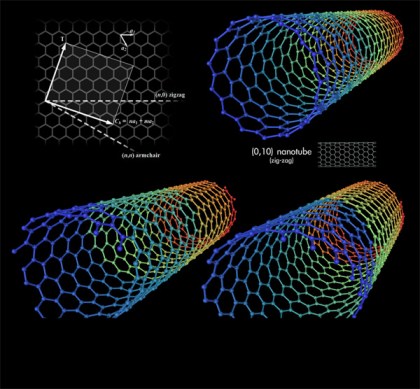 One of the most highly researched fields today is the production of carbon nanotubes. Carbon nanotubes hold high promise for many uses from a new generation of cancer treatment down to better electronic devices. The trick for researchers is to find a method of creating the nanotubes in bulk.
One of the most highly researched fields today is the production of carbon nanotubes. Carbon nanotubes hold high promise for many uses from a new generation of cancer treatment down to better electronic devices. The trick for researchers is to find a method of creating the nanotubes in bulk.
Researchers at Rice University have discovered a method of industrial-scale processing of pure carbon nanotube fibers. The breakthrough is the result of a nine-year program and the method builds on the processes that have been used by chemical firms for decades to produce plastics.
Researcher Matteo Pasquali from Rice said, “Plastics is a $300 billion U.S. industry because of the massive throughput that’s possible with fluid processing. The reason grocery stores use plastic bags instead of paper and the reason polyester shirts are cheaper than cotton is that polymers can be melted or dissolved and processed as fluids by the train-car load. Processing nanotubes as fluids opens up all of the fluid-processing technology that has been developed for polymers.
The researchers report that the new process builds on a discovery made in 2003 at Rice that found a way to dissolve large amounts of pure nanotubes in strong acetic solvents like sulfuric acids. The team of researchers found with further investigation that the nanotubes dissolved in the acidic solutions aligned themselves like spaghetti in a package to form liquid crystals that could then be spun into monofilament fibers about as thick as a human hair.
Researcher Wade Adams said, “That research established an industrially relevant process for nanotubes that was analogous to the methods used to create Kevlar from rodlike polymers, except for the acid not being a true solvent. The current research shows that we have a true solvent for nanotubes — chlorosulfonic acid — which is what we set out to find when we started this project nine years ago.”
To get the proof that the nanotubes were dissolving spontaneously in the chlorosulfonic acid the team had to invent new techniques to directly image the process.
“Ishi Talmon and his colleagues at Technion did the critical work required to help get direct proof that nanotubes were dissolving spontaneously in chlorosulfonic acid,” Pasquali said. “To do this, they had to develop new experimental techniques for direct imaging of vitrified fast-frozen acid solutions.”
Ishi Talmon said, “This was a very difficult study. Matteo’s team not only had to pioneer new experimental techniques to achieve this, they also had to make significant extensions to the classical theories that were used to describe solutions of rods. The Technion team had to develop a new methodology to enable us to produce high-resolution images of the nanotubes dispersed in chlorosulfonic acid, a very corrosive fluid, by state-of-the-art electron microscopy at cryogenic temperatures.”
According to the researchers, one major discovery remains before high-quality carbon nanotubes can be created and utilized. Current methods produce a myriad of different carbon nanotubes with different properties, lengths, and diameters. Researchers are working to find a method of crating only one type of carbon nanotubes. When batches of metallic conductive nanotubes can be created the use of nanotubes will boom.


